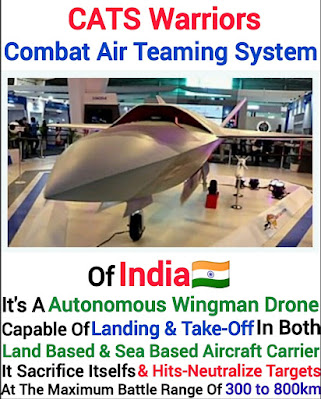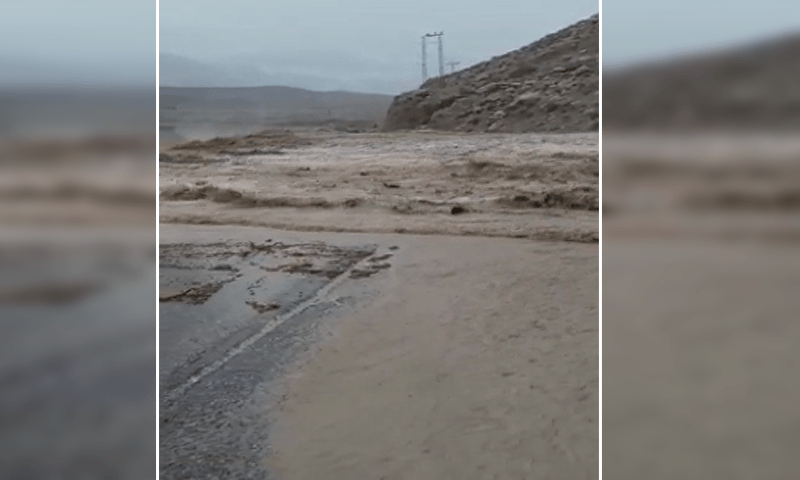HAL Working on Manned-Unmanned Combat Air Teaming system
The HAL Combat Air Teaming System (CATS) is a planned unmanned and manned combat aircraft air teaming system being developed by Hindustan Aeronautics Limited (HAL).
The system will consist of a manned fighter aircraft acting as “mothership” of the system and a set of swarming UAVs and UCAVs governed by the main aircraft. A twin-seated HAL Tejas is likely to be the main fighter aircraft. Various other sub components of the system are currently under development and will be jointly produced by HAL, National Aerospace Laboratories (NAL) Defense Research and Development Organization (DRDO) and a private firm named Newspace Research & Technologies. The primary aim is to make multiple advanced aerial platforms that can act as atmospheric satellite for high altitude surveillance, perform autonomous deep penetration precision strikes from standoff distance with maximum firepower while reduce human error and the threat on life.
CATS Warrior
CATS Warrior will be powered by an improved version of HAL PTAE-7 in a twin turbojet engine configuration which was previously used in DRDO Lakshya. Like the loyal wingman drone, it is also an unmanned stealth platform which can be controlled by the Mothership CATS LCA-MAX in formation of 2-4 warrior drone from as far as 150 kilometers and is able to fly alongside it to accomplish tasks such as scouting, absorbing enemy fire or even attacking the targets if necessary with its internal weapons. With 700 km of maximum range for self-destruct suicide missions, CATS Warrior can also carry a payload of 24 ALFA-S loitering munitions(carriers) up to 350 km for release and then safely return to base. In addition to swarm drones, it can also carry a total of 4 DRDO Smart Ant-Airfield Weapons(SAAW) – 2 x wingtips, 2 x internal bay. HAL is going to invest ?390 Crore ($53.5 Million) for the development of CATS Warrior platform for which the company management already gave its approval as of February 2021. The integration with CATS MAX will take 1-2 years and first flights is scheduled for 2024-25.
CATS Hunter
With KEPD 350 like appearance, the CATS Hunter will weigh 600 kg (1,300 lb) and will be powered by a single HAL PTAE-7 turbojet engine. It is designed as a low observable standoff air-launched cruise missile that can be integrated into CATS MAX, Mirage 2000, Jaguar or Su-30MKI and will consist of an interchangeable weapon carriage section based on mission profile that can carry 250 kg (550 lb) of unitary warhead or cluster munition(s) with a striking range of 200–300 km (120–190 mi). Once the payload is dropped at the designated target, CATS Hunter will be able to return and can be recovered through a two tier parachute system. It will use multiple global navigation satellite system (GNSS) and terrain contour matching (TERCOM) with mid-flight updates for guidance and an imaging seeker that can help in automatic target acquisition during terminal phase.
CATS ALFA
It is a carrier which will contains the Air Launched Flexible Asset-Swarm (ALFA-S) loitering munition. The carrier is capable of gliding and can cover around 100 km (62 mi) distance after being launched from the mothership. After reaching the desired distance, the ALFA-S can automatically separate from CATS ALFA and fly using its own propulsion thereby increasing the overall striking range. ALFA-S weighs 25 kg (55 lb), has foldable wings of 1 to 2 meter long and can carry 5 to 8 kilogram of warhead with a speed of 100 kilometer per hour. ALFA-S is a networked swarm drone that can detect surface to air missiles, radars and fighter jets stationed on ground. Using an artificially intelligent machine learning algorithm, the onboard mission computer and seeker on ALFA-S can perform autonomous target acquisition which can then assign and self lock on target to perform suicidal attacks using an individual or multiple drones. As per Group Captain Harsh Vardan Thakur from HAL Flight Operations Unit, a Sukhoi Su-30MKI aircraft can carry 30 to 40 ALFA-S during flight.
Under the India-US Defence Technology and Trade Initiative (DTTI), ALFA-S is the first joint project between Newspace Research & Technologies, HAL and the US Air Force Research Laboratory (AFRL). HAL will also help in the designing of CATS ALFA carrier platform that will air launch ALFA-S loitering munition. The first prototype of ALFA-S will be deployed on BAE Hawk 132 Advanced Jet Trainers.
CATS Infinity
Since the last few years, NewSpace Research & Technologies had already started developing systems such as CATS Infinity. In 2017, Boeing helped in validating the UAV and was impressed by the design and technological advancement of Infinity in the field of aerospace engineering. The first flight of the system designed for high altitude pseudo satellite (HAPS) role was planned from 2019. It is a solar powered high altitude drone with an endurance level as far as 3 months at a cruising altitude of 70,000 ft (21,000 m), weighing 500 kg. Infinity is designed to be equipped with terrain mapping camera and will have the capability of producing airborne real time cueing hyperspectral enhanced reconnaissance for deep strike aerial missions inside enemy territory. With a wingspan of 50 meters, the drone uses multiple ultra-lightweight electric motors that generates a speed of 90 to 100 kilometers per hour. New Space is working on high-density rechargeable Lithium-Sulphur batteries that will help constantly power the system for longer deployments.
It is also intended as a platform for real time communication and control of unmanned ground vehicles like Mobile Autonomous Stabilisation System (MASS), Mobile Autonomous Robot System (MARS) and Muntra developed by DRDO as well as in drone warfare under the CATS program. The Infinity platform is built as an Indian alternative for civilian and military drones like Maraal UAVs, Facebook Aquila, Airbus Zephyr and AVIC Morning Star of China.
As of July 2021, HAL had already started works on further improving the design of CATS Infinity with NewSpace Research & Technologies and is waiting for the approval from Ministry of Defence (MoD). As per HAL official, the development will take 3-4 years of time. The CATS Infinity will act as communication bridge between UAV and satellite(s), by providing live video feed and images of the battlefield



Comments
Post a Comment